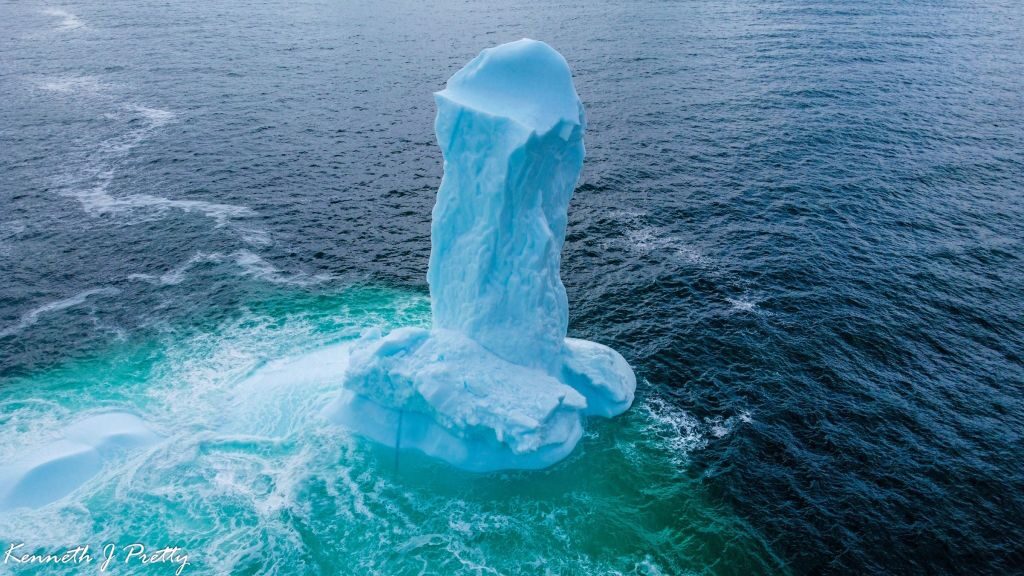
The suggestive 'berg consists of a column with a domed head protruding up from two oval rafts of ice. Photographer Ken Pretty captured a shot of the ice formation by drone near the town of Harbour Grace, which sits along — the puns keep adding up — Conception Bay.
Perhaps unsurprisingly, the "dickie berg," as locals are calling it, has attracted international attention, with Pretty sharing news stories from as far away as Thailand and Taiwan on his Facebook page.
"I knew I'd get a lot of comments, but I didn't expect this much," Pretty told the news agency Saltwire (opens in new tab) on Friday (April 28).

According to the CBC, it's a strong iceberg season in Newfoundland and Labrador, with more than 200 off the coasts of the two provinces.
"Onshore winds brought in both the pack ice and the bergs," Diane Davis, who runs a Facebook group for iceberg hunters, told the CBC. "If the trend holds up, we should see them for May and June, too. Mother Nature only gave us a handful last year."
Mother Nature has provided more than a handful of phallic shapes to giggle about. In 2021, a man went viral for his photographs of a penis-shaped rock tower in Arches National Park. Cambodian authorities have had to beg people to stop picking the carnivorous plant Nepenthes bokorensis, which just so happens to look like a penis. And don't even ask about California's plague of penis fish, which washed ashore on Drakes Beach in 2019. (They were actually marine worms, which have a long and storied history of looking phallic.)
Stephanie Pappas is a contributing writer for Live Science, covering topics ranging from geoscience to archaeology to the human brain and behavior. She was previously a senior writer for Live Science but is now a freelancer based in Denver, Colorado, and regularly contributes to Scientific American and The Monitor, the monthly magazine of the American Psychological Association. Stephanie received a bachelor's degree in psychology from the University of South Carolina and a graduate certificate in science communication from the University of California, Santa Cruz.



Reader Comments
Though what confuses me is the seething train behind the iceberg in the first photo. As if it was pulled in by a boat ...
As a mountain dweller, I made only a few and relatively short boat trips of 20 miles or less. Thus my pool of observations in this regard is somewhat limited ...
Why did he bring a magnifying glass to the beach? He was looking for seal-ants.
Poor attempt at humor. But also, the picture is not funny, so it worked out.
It is definitely intelligent design.
To the west of Trinity bay is Placentia Bay and on the isthmus between the two is Come By Chance
But I'd be curious if you asked the whole group of 31 whether their lives are better now after they "won" the lottery...
My guess is about 30% (maybe more) would say - come to think of it - No. I wish we hadn't won that money .
What you think?
Are my odds off?
Being debt free is the first step to freedom!
~
Is your life better now or would you prefer to go back to how it was before this lottery money dropped in your lap?
~
Do you know, I just happened to be posting on a SubStack place where the author, a smart person indeed, seems to be advocating for MMT and $5 million smackaroos for all the black folk been treated wrong? I sort of have a hard time coming to terms with anybody thinks money is gonna solve problems.....and moreover, when do the reparations come to an end. Because, literally, let me go find the post I posted at this place: [Link]
Mammon is the root of all evil I reckon....serpents need to have their tails cut off and then kill them before they get back into the cave.
"$5 million smackaroos for all the black folk been treated wrong" .. is that each or another racist con based on the assumption blacks can't do maths?
As you say, if descendants of people that got given free passage from Africa ( ) get reparations, that should set a precedent, "gingers" around the world can undoubtably claim for the eradication of their Neanderthal ancestors and I've got my own share of DNA trauma from when the French invaded England in 1066
But of course I'm kidding around because the whole concept of reparations is flawed - just like mmt is...
so flawed the flaws will soon be evident.
the tender looked at the priest and said - get out of this establishment you DICK
Must be.
Cornelis Cornelisz. van Haarlem - The Fall of the Titans - Google Art Project - The Fall of the Titans - Wikipedia
[Link]
Phallus Impudicus: All About The Stinky Penis Mushroom - [Link]
Impudicus : 1) shameless, impudent 2) unchaste, impure, immodest, immoral, lewd
We strive to be educational here
Cause I agree - tis learning that matters - every day one day at a time.
Ken